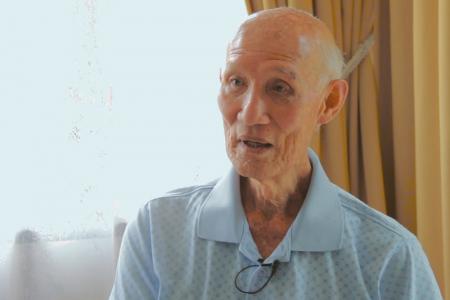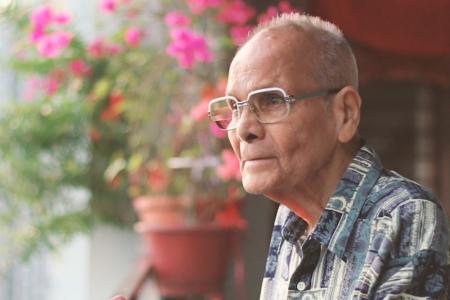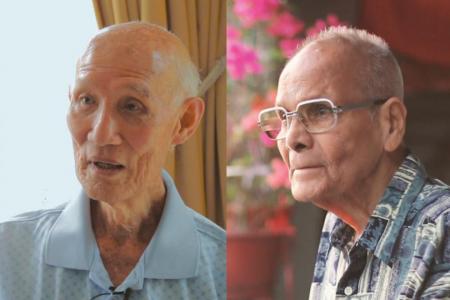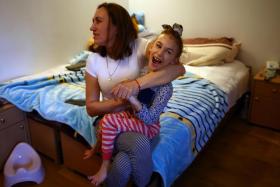Surviving the Japanese Occupation
This story has been updated to reflect the Change in exhibition
They were only teenagers when Singapore was invaded by Japanese forces, witnessing one of the darkest periods in Singapore's history.
To ensure that the struggles from that era are never forgotten, two men, Mr Tan Hwee Hock and Mr K. Nadarajah have recounted their experiences for an exhibit, now named Surviving The Japanese Occupation: War and Its Legacies, at the former Ford Factory.
The exhibition in Upper Bukit Timah Road marks 75 years since Singapore fell to the Japanese during World War II. Singapore was renamed Syonan-to by the Japanese in 1942. It means "Light of the South".
The New Paper spoke to Mr Tan and Mr Nadarajah about their lives during wartime and of the recent controversy over the exhibition's name.
MR TAN HWEE HOCK, 87
I was 13 when the Japanese invaded.
Obviously, we were all very frightened of them. We did not know how to react. They were completely different to us.
I mostly stayed home and tried to mind my own business.
At the time, you needed a purple-ink 'chop' on your hand to move about in public. That chop was very precious.
Whenever you walked past a Japanese sentry, you had to bow as a show of respect. If you didn't, you risked being beaten to death.
When the call came for conscription, I volunteered to be in the medical assistance service. I thought that being a boy scout in primary school made me knowledgeable enough to help.
SURVIVING ON $2.50 A DAY
When I was 15, I found work as a laboratory assistant to the Japanese who were doing scientific studies on metabolism.
With my $2.50 per day wages, I would collect rice rations. We carried them in cigarette tins.
That rice was more precious than the wages itself.
Sometimes, I would get a whiff of soft, white bread baked fresh in the bakery. These loaves were only for the Japanese.

All we had was hardened slabs of cornflour mixed with foul-smelling oil.
At home, my father turned our garden into a plot for growing sweet potato and tapioca, which we fertilised with our own urine.
EVERY GRAIN IS PRECIOUS
You don't realise how valuable daily commodities are until they're gone.
That's why it pains me to see young people wasting food these days, peeling off the edges of white bread and saying "so what?".
There were times during the war I even collected fallen grains from the godown (warehouse) labourers carrying gunny sacks of rice.
Every grain was precious.
That's why when I raised my family after the war, I made sure that no one wasted a single grain of rice during meals.
The hallmark of my generation is frugality.
We needed to be frugal to survive, there was no other way.
MR K NADARAJAH, 89
The war turned our lives topsey turvey.
I remember it as if it was a dream.
My family of six was living in Kuala Lipis, the then capital of Pahang in central Malaysia, before the war broke out.

My father was a Traffic Inspector on the Malaya railways. He would leave the house early in the morning - at about 6am - and return by the last train at 7pm.
When the Japanese landed (in December 1941) north of Kuala Lipis, my father was up at 3am on the telephone arranging trains to evacuate railway employees.
During the war, the trains going south were ambulance trains. They were filled with wounded soldiers covered in bloodied bandages.
Trains going north carried war materials and troops.
A BRUSH WITH DEATH
One day, a British Bren gunner outside my house took shots at the Japanese planes heading North. Then the planes turned and attacked our town.
My father was in the railway station but he ran back to the house when this happened.
He bundled my mother and two sisters out of the house and onto the footpath, which offered some shelter since it was at the bottom of a hillock.
The bullets came through the leaves of the trees like heavy rain drops.
Finally, the sirens blew the 'all clear' and we got up, looked at each other and quietly walked home.
CAPTURED, TORTURED
After the British surrendered (in February 1942), the Japanese transferred my family to Singapore.
At my father's workplace, a colleague had concealed a radio in the ceiling so they could listen to foreign broadcasts and keep abreast of the war outside Malaya.
But this was leaked to the local police. So the Special Branch kept key men from the railway under observation but one morning, Japanese soldiers armed with bayonet-attached rifles raided our house and arrested my father.
They interrogated and tortured him at the Central Police Station in South Bridge Road.
My father fell ill as a result and was admitted to Tan Tock Seng Hospital.
I was only 14 and was assigned the twice-daily task of delivering food cooked by my mother to him.
Buses did not run regularly and I was too impatient to wait for the trains so I would walk the three miles between my home in Spooner Road to the hospital each time.
I could not recognise my father when I first visited him in the ward.
He had become haggard with long, unkempt hair, a long messy beard and tattered clothes.
He was so badly beaten he could hardly sit up.
As he recovered, the Japanese took him back for interrogation and a court case ensued.
He was sentenced to 20 years in jail because the Japanese judge said it was slower and more painful than cutting off his head.
Upon Japan's surrender, my father was released though he suffered from amnesia because of all the beatings.
HERO OF THE HOUSEHOLD
In all these trials, I feel my mother suffered more because she had to endure all of this without the help of a husband.
Eggs, meat and rice were scarce and could only be bought at the black market at exorbitant prices.
But she made sure we got them so my father could have dinner every day.
She didn't complain once and was a bastion for all of us children. But this took much out of her. In 1946 (the year after the Japanese surrender), she succumbed to gall bladder cancer at the age of 48.
NAMING OF SYONAN GALLERY
It is good they call it Syonan. After all, Singapore was named 'Syonan-to'.
It suits the period of the Occupation, and it means a lot to those who went through it.
It reminds people of the war times and all the hardships and losses families suffered.
Without this name, people will just think it is like any other war memorial.
Mr Tan's Syonan Labour Department labour identity booklet, which logged his wages, and his medic worker armband, are both on display at the exhibition.
Mr Nadarajah's oral account of his war experiences are also featured in the new exhibits.
'Surviving The Japanese Occupation: War and Its Legacies'
OPEN: 9am to 5.30pm (Monday to Saturday)
12pm to 5.30pm (Sunday)
WHERE: 351 Upper Bukit Timah Road, Singapore 588192.
ADMISSION: $3
FREE ADMISSION TO:
• All children under 6
• Singaporeans and permanent residents
• Singapore student pass holders
• Museum Roundtable members
Free admission to all on Open House Days.
For more information: www.nas.gov.sg/syonangallery.
Get The New Paper on your phone with the free TNP app. Download from the Apple App Store or Google Play Store now


